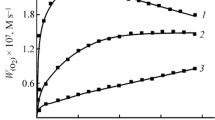Abstract
We have reported that the peroxyl radicals derived from methyl eicosapentaenoate (20:5n-3) are more polar than those from methyl linoleate (18:2n-6) since the former peroxyl radicals have at least two molecules of oxygen in a molecule while the latter peroxyl radical has one. This lowers the oxidizability for 20:5n-3 in aqueous Triton X-100 micelles by enhancing the termination reaction rate for peroxyl radicals and by reducing the rate of propagation since there may be more polar peroxyl radicals derived from 20:5n-3 at the surface than within the micelle core. In this study, we measured the effect of three antioxidants, di-tert-butyl-4-methylphenol (BHT), 2,2,5,7,8-pentamethyl-6-chromanol (PMC) and 2-carboxy-2,5,7,8-tetramethyl-6-chromanol (Trolox), on the oxidation of lipids in aqueous micelle. Antioxidants give a clear induction period during oxidation of 18:2n-6 initiated with a water-soluble radical initiator, and its induction length decreases in the order of BHT>PMC>Trolox. This is consistent with the proposed location of three antioxidants: being in the core of micelle, at the surface, or in aqueous phase, respectively. However, BHT does not inhibit the oxidation of 20:5n-3 efficiently, and its rate of oxidation is slower than that observed in the oxidation of 18:2n-6, supporting the idea that polar peroxyl radicals derived from 20:5n-3 are preferentially located at the surface of the micelle. Similar results were obtained when oxidation was initiated with a lipid-soluble radical initiator except antioxidants had lesser effect on the oxidation rate of 20:5n-3.
Similar content being viewed by others
Abbreviations
- 18:2n-6:
-
methyl linoleate
- 20:5n-3:
-
methyl eicosapentaenoate
- AAPH:
-
2,2′-azobis(2-amidinopropane)dihydrochloride
- AMVN:
-
2,2′-azobis(2,4-dimethylvaleronitrile)
- BHT:
-
2,6-di-tert-butyl-4-methylphenol
- PMC:
-
2,2,5,7,8-pentamethyl-6-chromanol
- Trolox:
-
2-carboxy-2,5,7,8-tetramethyl-6-chromanol
References
Howard, J.A., and Ingold, K.U. (1967) Absolute Rate Constants for Hydrocarbon Autoxidation. VI. Alkyl Aromatic and Olefinic Hydrocarbons, Can. J. Chem. 45, 793–802.
Yamamoto, Y., Niki, E., and Kamiya, Y. (1982) Quantitative Determination of the Oxidation of Methyl Linoleate and Methyl Linolenate, Bull. Chem. Soc. Jpn. 55, 1548–1550.
Yamamoto, Y., Niki, E., Kamiya, Y., and Shimasaki, H. (1984) Oxidation of Phosphatidylcholines in Homogeneous Solution and in Water Dispersion, Biochim. Biophys. Acta 795, 332–340.
Cosgrove, J.P., Church, D.F., and Pryor, W.A. (1987) The Kinetics of the Autoxidation of Polyunsaturated Fatty Acids, Lipids 22, 299–304.
Bruna, E., Petit, E., Beijean-Leymarie, M., Huynh S., and Nouvelot, A. (1989) Specific Susceptibility of Docosahexaenoic Acid and Eicosapentaenoic Acid to Peroxidation in Aqueous Solution, Lipids 24, 970–975.
Miyashita, K., Nara, E., and Ota, T. (1993) Oxidative Stability of Polyunsaturated Fatty Acids in an Aqueous Solution, Biosci. Biotech. Biochem. 57, 1638–1640.
Yazu, K., Yamamoto, Y., Ukegawa, K., and Niki, E. (1996) Mechanism of Lower Oxidizability of Eicosapentaenoate Than Linoleate in Aqueous Micelles, Lipids 31, 337–340.
Alauddin, M., and Verrall, R.E. (1984) Apparent Molal Volume studies of 2,6-Di-tert-butyl-4-methylphenol, 2-tert-Butyl-4-methoxyphenol, and 2,6-Di-tert-butyl-4-(hydroxymethyl)phenol in Aqueous Micelle Solutions of Sodium Dodecanoate as a Function of Micelle Concentration and Temperature, J. Phys. Chem. 88, 5725–5730.
Alauddin, M., and Verrall, R.E. (1984) Apparent Molal Volume Studies of 2,6-Di-tert-butyl-4-methylphenol, 2-tert-Butyl-4-methoxyphenol, and 2,6-Di-tert-butyl-4-(hydroxymethyl)phenol in Aqueous Micelle Solutions of Cetyltrimethylammonium Bromide as a Function of Micelle Concentration and Temperature, J. Phys. Chem. 90, 1647–1655.
Bidzilya, V.A., Golovkova, L.P., Vlasova, N.N., and Bogomaz, V.I. (1995) Solubilization of α-Tocopherol and Its Analogs in Aqueous Solutions of Nonionic Surfactant, Colloid J. 57, 157–159.
Castle, L., and Perkins, M.J. (1986) Inhibition Kinetics of Chain-Breaking Phenolic Antioxidants in SDS Micelles. Evidence That Intermicellar Diffusion Rates May Be Rate-limiting for Hydrophobic Inhibitors Such as α-Tocopherol, J. Am. Chem. Soc. 108, 6381–6382.
Burton, G.W., and Ingold, K.U. (1981) The Antioxidant Activity of Vitamin E and Related Chain-breaking Phenolic Antioxidants in vitro, J. Am. Chem. Soc. 103, 6471–6477.
Burton, G.W., Doba, T., Gabe, E.J., Hughes, L., Lee, F.L., Prasad, L., and Ingold, K.U. (1985) Maximizing the Antioxidant Activity of Phenols, J. Am. Chem. Soc. 107, 7053–7065.
Author information
Authors and Affiliations
About this article
Cite this article
Yazu, K., Yamamoto, Y., Niki, E. et al. Mechanism of lower oxidizability of eicosapentaenoate than linoleate in aqueous micelles. II. Effect of antioxidants. Lipids 33, 597–600 (1998). https://doi.org/10.1007/s11745-998-0245-3
Received:
Revised:
Accepted:
Issue Date:
DOI: https://doi.org/10.1007/s11745-998-0245-3



